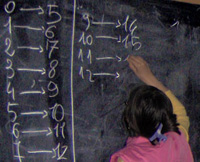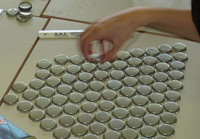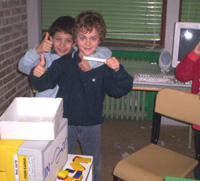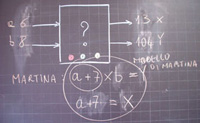Scientists at play: teaching science process skills Teach article
Sometimes in the wealth of detail of modern science, we lose sight of the unifying factor: the scientific method. Alfredo Tifi, Natale Natale and Antonietta Lombardi explain how they encourage the skills of enquiry, hypothesis and testing.

Process skills are fundamental to science, allowing everyone to conduct investigations and reach conclusions. We are convinced that there is a serious educational gap in this area, both in bringing these skills into the classroom and in training teachers to do this. It is obviously a multifaceted problem, which involves school administration and teacher education, as well as the development by students of the necessary social skills to collaborate effectively, share, debate, defend and extend ideas in groups. To facilitate the introduction of science-enquiry principles in school, we developed a set of lab activities for use in primary and secondary schools.
Most school science practical lessons are based on content: doing experiments to determine the variables that affect bean growth, for example. Even when those practical sessions are well managed, the contents often overwhelm the process of investigation, preventing students from extrapolating what they are doing to more general principles of scientific method. To develop a scientific way of thinking, students need “multiple opportunities to work with these skills in different content areas and contexts”.w1
Thus our approach has been to create content-free laboratory games where the focus is on the process rather than on particular scientific content. Process skills tend to last longer than learned content, and we believe these thinking patterns can be readily transferred to new situations. We think that method-based, hands-on investigative activities should be a significant component of science teaching, at the same level as hands-on content-based activities, rather than both being superficially covered even in the more fortunate schools.
From content-based activities to black boxes
In the past, our group has researched content-based hands-on activities in subjects ranging from the properties of matter to materials, interactions and systems and energy. We were inspired by the Science Curriculum Improvement Innovation Study program, from which we had drawn content such as variables and models and theories, without being completely aware that these were mainly process areas. During our research on modelling activities we discovered that:
- Students in the grades 3-5 (age 8-12) found highly demanding activities based on investigation and modelling challenging and amusing.
- Younger students used a lot of imagination to make sound hypotheses about relevant problems.
We concluded that enquiry can be the most appealing part of science for students of every age, and that children’s imaginations permit them to carry out abstract processes.
So, over the past two years we concentrated on developing activities in which students probe black-box systems or phenomena. Their task is to find patterns, develop explanations and build models that reproduce the behaviour of these black-box systems. Working out a model implies activating most science process skills: observing, inferring, predicting, controlling variables, hypothesising, planning experiments and carrying them out.
The black boxes need to be tailored to the age and level of the classes. Some examples are given below.
Grades 1-2 (age 6-8)
Children shake a sealed can. They weigh it, listen to the sounds, and try to guess what materials or objects are contained inside. There is a software counterpart of this game for older students in which a hidden object must be identified through simulated tests: squeezing, dilution, flame-testing, weighing, X-ray analysis, two-dimensional sonar imaging and magnetismw2.
Children in grade 2 (age 7-8) and above can also use the operating machines described below.
Grade 3 (age 8-9)
In the ‘circuit game’, students use a self-made lamp probe and contact points to reveal a hidden network of connections made from aluminium strips. When students remove the cover and see the real circuit, they are usually disappointed because it differs from their prediction.
Grade 4 (age 10-11)
The ‘dice-in-a-box’ game has a dice with coloured faces in a box with a translucent window, so that only one face of the dice is visible at any time. Students must toss the dice in the box, guess how many of the faces have which colour, and draw an unfolded, two-dimensional model of the dice. This demonstrates to the children that scientists need to design models when they are unable to directly examine real objects. As an example, we tell students that the earth’s core is just a model that was drawn from studies of how seismic waves are reflected at a certain depth, from which the existence of a discontinuity was deduced.
Grades 5-8 (age 11-14)

tops
In pattern experiments, students have to find regular patterns among coupled variables. For example, in a triangular array, they try to determine the relationship between the side number and total number of bottle tops.
Using a plastic Slinky®, the students try to determine the relationship between the rhythm of oscillations and the number of coils free to oscillate. In another experiment, they deduce from the elongation of a spring how many coins are weighing it down. Using a guitar string, they try to determine the relationship between tension and pitch.
In other experiments, the students make predictions graphically or using empirical mathematical relations, without mechanistic explanations based on physical laws.
Work in progress
Thanks to in-service teacher trainers and other volunteer tutors, we are testing a range of tools with students. We are keen to gain support from an educational research institution, to be able to plan and implement systematic teacher training. By reassessing teacher training, awareness could be raised of science-process principles, in line with European projects to introduce enquiry-based methodology into science educationw3,w4.
Operating machines
These games involve ‘transformer machines’ that are fed input and emit processed elements of the same type. The elements can be attribute blocks or integer numbers.
Attribute block machines: ideal for grades 2-3
This activity uses coloured attribute blocks – a typical Italian set has 48 pieces (four shapes, three colours, two dimensions and two thicknesses). The ‘attribute transformer machine’ changes one or two attributes at a time according to a rule. For example, the transformer rule might be ‘ALL red OR thick blocks become yellow AND big’. Other blocks remain unchanged as they pass through the machine. The class conducts experiments to guess the mechanism. This involves a series of trials, an analysis of outcomes, the development of hypotheses, and tests to confirm or discredit these hypotheses, to create more or less stable models.

transformer machines
When we begin this game, we let a student play the role of a ‘virtual transformer machine’, holding the rule in his or her head. The student might think up the mechanism, or it might be chosen from a set of mechanism cards prepared beforehand. The other children play the roles of investigators, with the goal of predicting the outcome of the transformation. The student who is running the mechanism puts the input block into a box and extracts the output block.
Students could then progress to the software version, MOBL (the Italian acronym for attribute blocks operating machinew5). This can also be projected onto a screen while the class tackle the problem as if they were a team of scientists. If there are enough computers, they could also work in groups of three to four.
Numeric operating machines
These machines have integers as inputs and outputs. Transformations involve the four elementary operations, odd-even comparison, < = >, modulo, and combinations of these operations for higher levels.
To introduce the number-operating machines, the students can simulate the machine, as above.

We have developed three software machinesw6, MO11, MO12 and MO21, the names of which indicate the number of inputs and outputs. MO21 is the most intriguing because of the opportunity it offers to control two experimental variables (Table 3). Currently, we are developing operating machines that can be used online. Teachers or children can select the appropriate level of complexity of the transforming mechanism, from grade 2 (age 7-8) up to high school.
These machines permit the students to save the hidden randomly generated mechanism and to reload it later, allowing more difficult investigations to be shared with or delegated to other ‘scientist teams’. With this option, we aim to encourage persistence and to foster cooperative strategies, both of which are fundamental to scientific work. The following tables show examples of trials and experimental outcomes.
| INPUT | 3 | 5 | 8 | 4 | 1 |
|---|---|---|---|---|---|
| OUTPUT | 4 | 8 | 14 | 6 | 0 |
As the students use the operating machines, they discover that the models must be changed as new evidence is acquired. There are different models possible to explain Table 1, for example:
- Output = input + (input – 2)
- Output = (2 ( input) – 2
Children of different ages envisage these models very differently – primary school children will not think of them in terms of algebra, of course. For very young children, mechanism a) is beyond their comprehension for numbers below two, because they are unable to calculate (1 – 2) or (0 – 2).
As teachers lead these activities, they should concentrate on highlighting the underlying principles: students need to become aware of the skills and principles they are using, and to talk about them using general terms such as variables, outcomes, predictions, evidence, experiments, tests, hypotheses, confirmation and models. We consider that this vocabulary makes up 50% of process skills and meta-cognition; the other 50% lies in applying these skills in authentic problem-solving activities.
Some basic principles of the science process skills that emerge are:
- Both input and output data in experiments must be recorded.
- The first approach to exploring a phenomenon involves ‘open field’ experiments.
- Experiments should be conducted according to a systematic plan.
- Data from the experiments should be presented according to specific ordering criteria; some presentations are better than others to help the enquirer recognise a pattern.
- Effective models must account for all the experiments, rather than each piece of evidence from the experiment having a separate model
| INPUT | 1 | 2 | 3 | 4 | 5 |
|---|---|---|---|---|---|
| OUTPUT | 0 | 2 | 4 | 6 | 8 |
| INPUT | 2;1 | 2;2 | 2;3 | 3;2 | 1;2 |
|---|---|---|---|---|---|
| OUTPUT | 3 | 4 | 5 | 4 | 4 |
Contraptions
The principle behind contraptions is similar to that of operating machines, but these are physical black-box machines that have at least two external, movable parts that act as input and output. The parts may be coloured threads, rotating knobs or stems, penetrating bars or tilting levers. The two are coupled through an inner mechanism of gears, pulleys, belts and wheels.
Submit your own contraptions!
In the next issue of Science in School, Alfredo Tifi, Natale Natale and Antonietta Lombardi will describe some of the contraptions they have developed and provide detailed instructions for building them. In the meantime, why not send us your own ideas and designs for contraptions to develop process skills in students?
Final comments
We would be delighted if this project contributes to and triggers similar ideas and a discussion on method-based science practical sessions. We are convinced that a crucial ingredient of doing science – the development of process skills – should be taught first in content-free investigations, where more attention can be paid to the spontaneous discovery, elicitation, generalisation and sharing of principles captured by authentic problem solving. From this starting point, students can move on to content-based enquiry. True experimental contexts bring in high levels of background noise, and put a heavy load on the memory; in this context, it is almost inevitable that process skills are neglected.
Web References
- w1 – Padilla MJ (1990) The Science Process Skills
- w2 – Laboratorio. Download or execute here
- w3 – Scienceduc
- w4 – ‘Pollen’ Project
- w5 – Download or execute MOBL software here
- w6 – Download operating machines here
Resources
- Proceedings of European Summer School for Primary Science Trainers (held in Sicily from 9-14 July 2005)
- Metzenberg S. Reading: The Most Important Science Process Skill
Review
This article deals with science process learning in school, and I recommend it for teachers in both primary and secondary schools. It emphasises the importance of teaching science enquiry principles from grades 1-2 upwards.
Sølve Marie Tegner Stenmark, Norway





